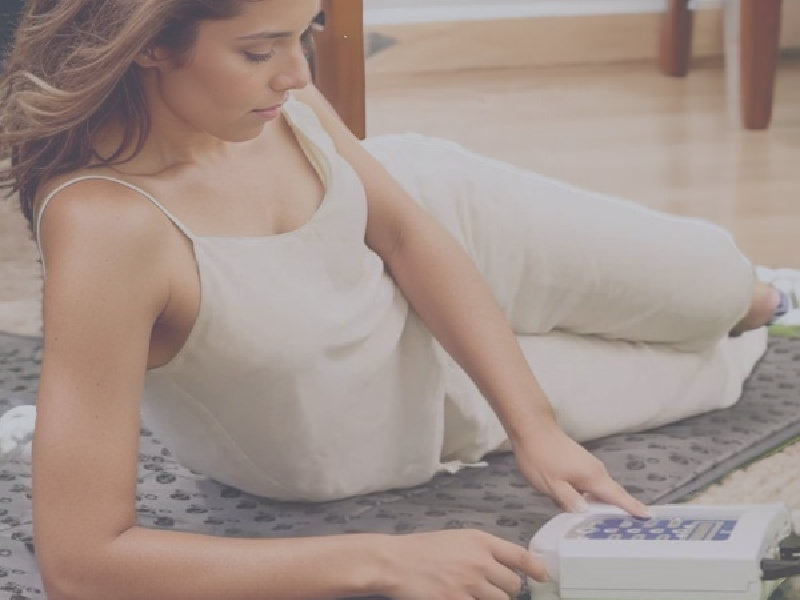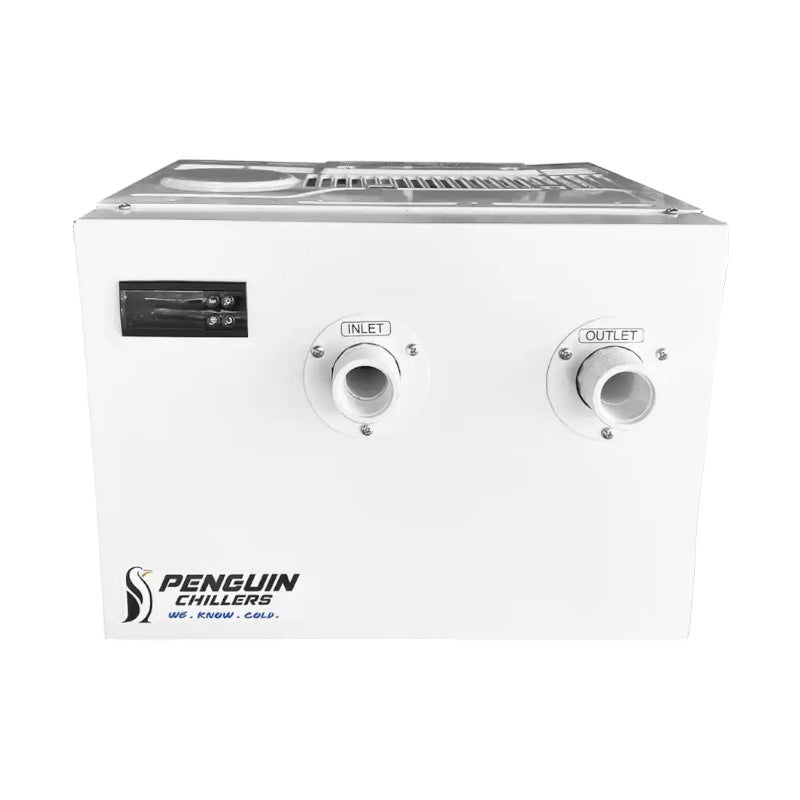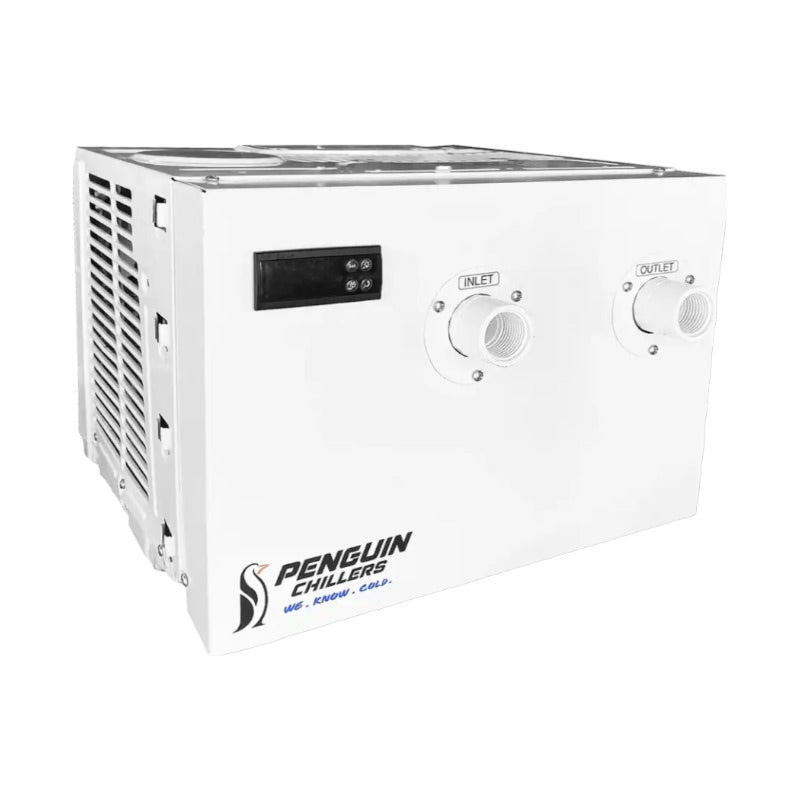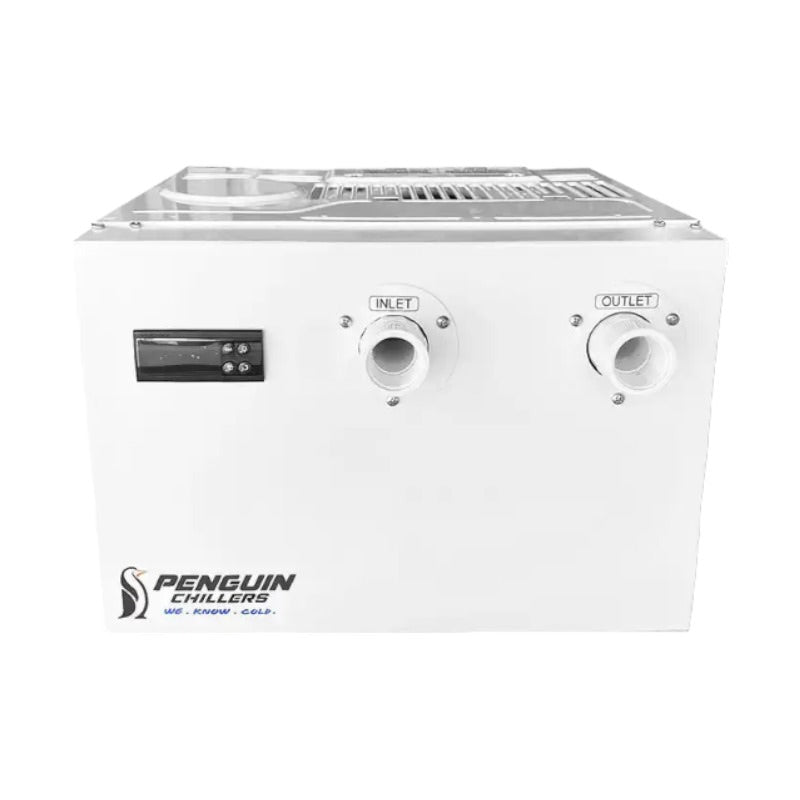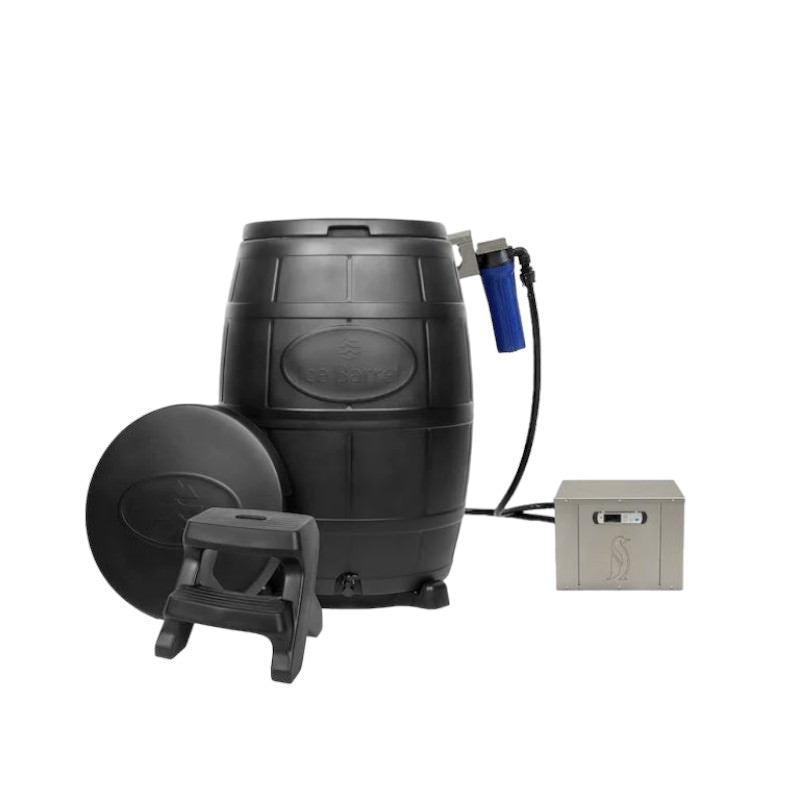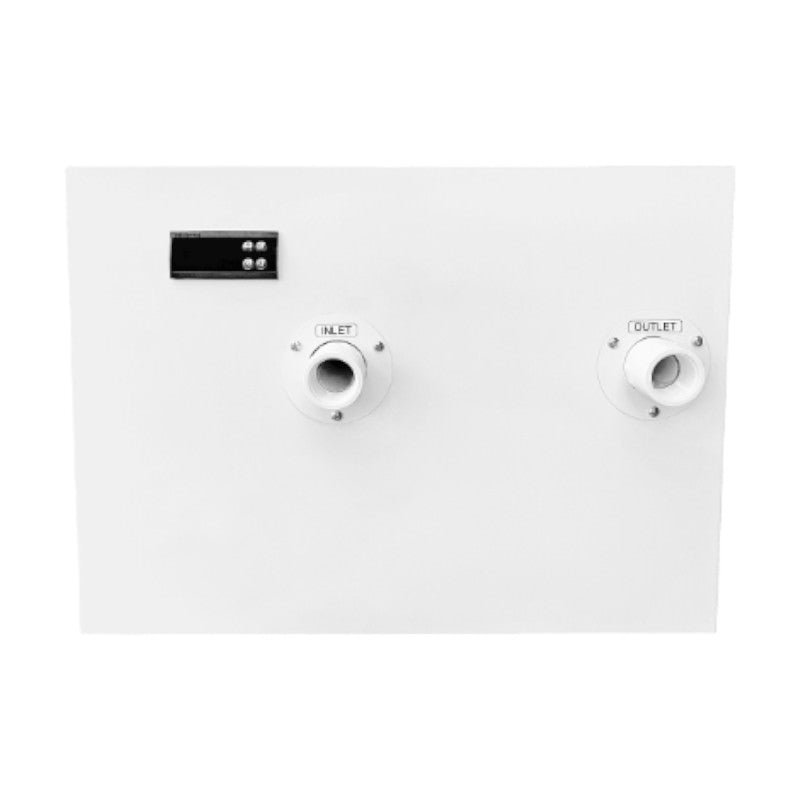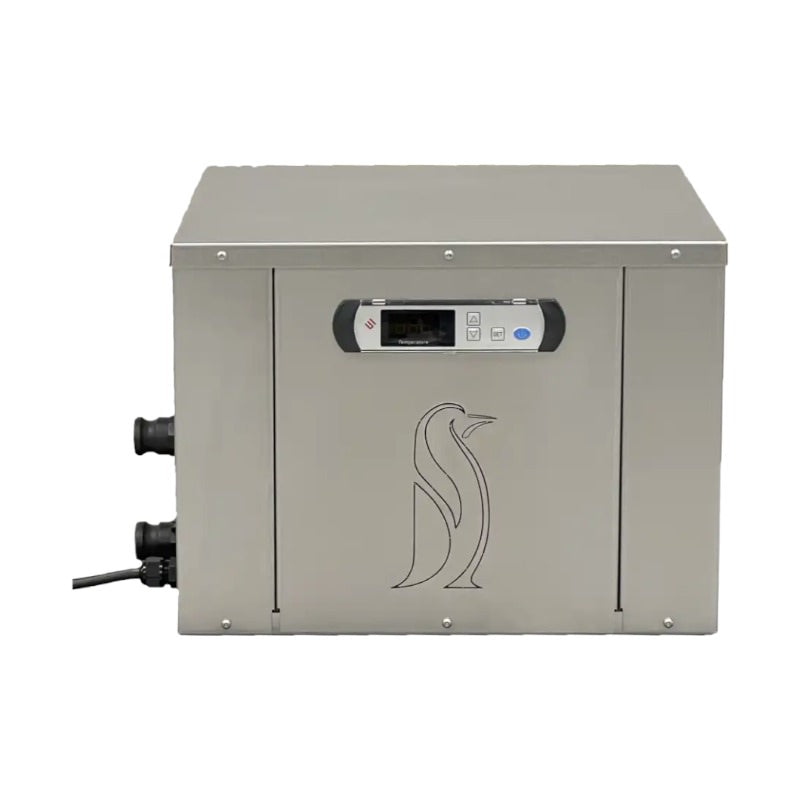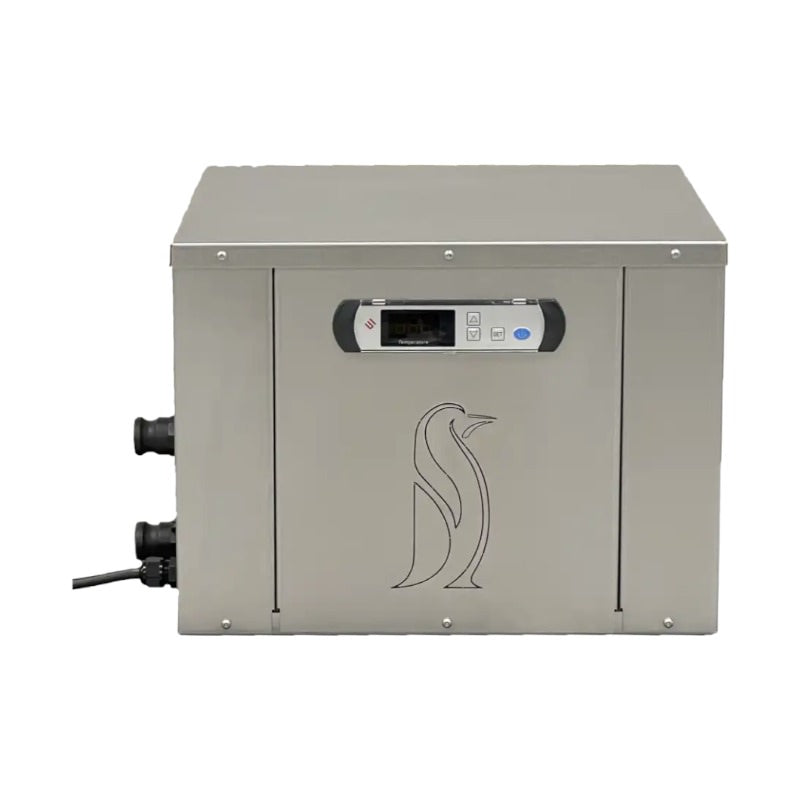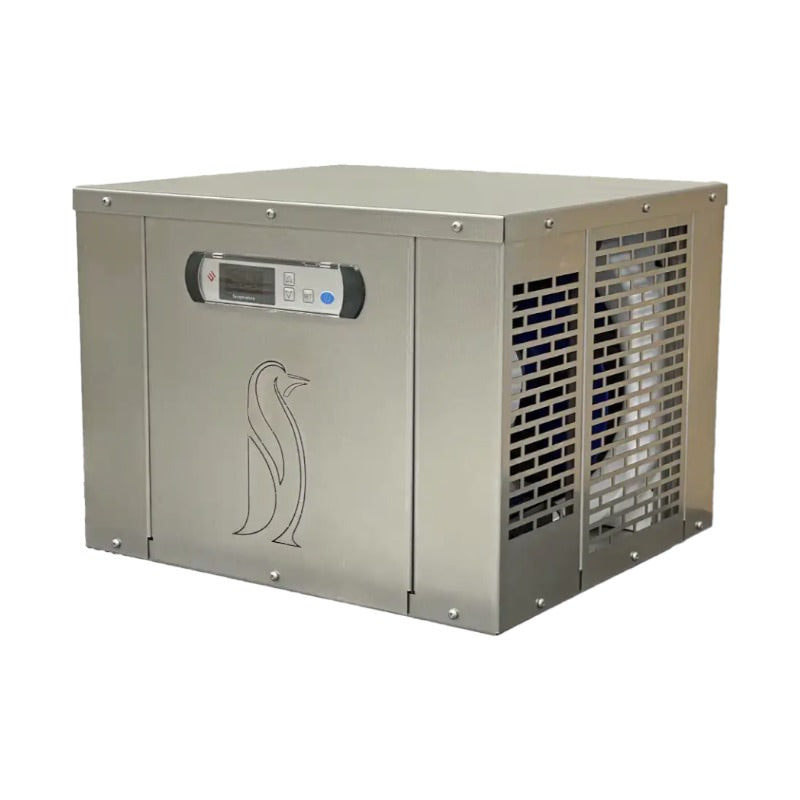Water Chiller for Ice Bath & Cold Plunge
If you're someone who regularly uses ice baths for cold water therapy, then you might benefit from investing in a water chiller. This device eliminates the inconvenience and expense of buying ice and helps keep your water perfectly cold and filtered. Without a water chiller, it can be challenging to control the temperature, which can affect the effectiveness and safety of the therapy.
If you already have tub and looking to ditch the ice, you will need a high-capacity chiller, a pump, and a filtration system. Depending on the type of chiller you buy these accessories might be included.
Understanding Chillers
Sizing a Chiller:
| Volume of Tub (Gallons) | Recommended Chiller Size (HP) |
|---|---|
| 50 - 150 | 1/4 to 1/2 HP |
| 150 - 200 | 1/2 HP to 1 HP |
| 200 - 400 | 1 HP to 1.5 HP |
Selection Tip: Choose a chiller based on the volume of your cold plunge tub and the temperatures you desire to achieve a consistent and reliable cold therapy experience.
Popular Products:
Best Plug & Play (and best for outdoor ice baths): Penguin Chiller's Cold Plunge Chiller.
Best DIY chiller: Penguin Chiller's 1/2 HP Water Chiller.
Best chiller if you own an Ice Barrel: Water Chiller with Bracket
Best if you do not own a tub: Cold Tubs with Chiller Bundles.
Benefits of Using a Water Chiller for your Ice Bath Journey
Consistent Temperature Control
Imagine stepping into your ice bath and experiencing the perfect degree of cold every single time. That's what a water chiller offers: reliable and Consistent Temperature Control. Unlike ice cubes that melt and change the water temperature, a chiller keeps your ice bath at the exact coldness you've set, anywhere typically between 45°F and 55°F (7°C - 13°C). This level of control is essential for those seeking therapeutic benefits from their ice baths, as it helps to ensure optimal muscle recovery and inflammation reduction without the risk of the water becoming too cold or too warm.
Faster Cooling Time
Waiting for water to drop to the right temperature can be a tedious part of the process. However, with a high-quality water chiller, you'll enjoy a Faster Cooling Time. Advanced models can lower water temperature to 37°F (3°C) swiftly, eliminating the wait and making it more convenient to fit a cold plunge into your schedule. This quick action is particularly beneficial if you're looking to reduce downtime in your wellness routine or if you need a rapid cool down after an intense workout session.
Energy Efficiency
In today's world, Energy Efficiency is more than just a buzzword; it's a necessity. Using a water chiller for your ice baths can be more energy-efficient than constantly buying and using ice. Chillers are designed to maintain low temperatures without the same level of energy drain that ice production and refrigeration can cause. Your cold plunge setup becomes not only more sustainable but also potentially cost-effective in the long run as you save on energy bills. Plus, many chillers come with energy-saving features that minimize their ecological footprint while still providing the chilling power you need.

Installation and Setup
When installing your cold plunge with a chiller, precision in selecting the right location and following the installation process is key to ensure everything functions correctly and safely.
Choosing the Right Location
- Accessibility: Choose a location that allows for easy access to the cold plunge, both for use and maintenance.
- Flooring: Ensure the chosen area has a sturdy, level surface that can handle weight and potential water exposure.
- Ventilation: Good airflow helps with temperature regulation and moisture control.
- Proximity to Power Source: The chiller needs to be near an electrical outlet for power without the use of extension cords.
Installation Process
- Unpack: Carefully remove the chiller and all components from the packaging.
- Connections: Connect the chiller to the plunge pool using the provided hoses or connectors, taking care not to overtighten and cause damage.
- Power Supply: Plug the chiller into a nearby outlet and ensure it has a dedicated power supply to avoid tripping circuits.
- Water Fill: Fill your plunge pool with water up to the recommended level, ensuring no leaks.
- Test Run: Power on the chiller and allow it to run until the desired temperature is reached, checking for proper operation.
Remember to consult your user manual for specific guidelines and safety considerations.
If that's too complicated and you prefer to shop a ready made ice bath and chiller system shop our ice bath & cold plunges.
Types of Water Chillers for Ice Baths
When diving into the world of cold water therapy, you'll come across various types of water chillers, each designed to cater to your specific needs. Understanding the differences between the types of chillers available will ensure you equip yourself with a system that maximizes efficiency and aligns with your wellness goals.
Recirculating Water Chillers
Recirculating Water Chillers are the go-to for consistent and rapid cooling. They operate by continuously pumping water through a cooling unit, maintaining a stable water temperature throughout your ice bath session. This type of chiller is built for speed and can swiftly bring down water temperatures, which is particularly beneficial if you're looking to minimize preparation time.
Most recirculating chillers will have the flexibility of fine-tuning temperatures to your desired level. They often come with digital interfaces, allowing precise control over your bathing conditions. With models capable of reaching as low as 2ºC (35ºF), they cater to even the most extreme cold therapy enthusiasts.
For those with space constraints, the more compact models are ideal. They can be easily stored and moved, providing a convenient option for those who require portability. It's critical to assess the power of these models in accordance with your needs—some are built to cool up to 2000L, a considerable volume for any ice bath routine.
Immersion Water Chillers
On the flip side, Immersion Water Chillers offer a direct cooling approach. By directly placing the cooling element into the water, these chillers cool the water surrounding it effectively. This method is particularly advantageous for home brewers seeking precise yeast pitching temperatures, as immersion chillers can significantly reduce water temperature.
Immersion chillers are simpler in design and often lightweight, which makes them a breeze to maneuver. They don't require complex setups and are perfect if you're after a straightforward cooling solution. Despite their seemingly modest approach, they are highly capable of achieving the low temperatures needed for effective ice baths, ensuring your muscles receive the optimal cold exposure needed for recovery.
Both recirculating and immersion water chillers boast features that cater to your specific temperature and capacity requirements. Evaluate your preferences in terms of ease of use, temperature range, and volume capacity to determine which chiller will offer the most substantial benefits for your ice bath therapy. With the right chiller, maintaining and controlling your cold plunge has never been simpler.
Factors to Consider When Choosing a Water Chiller for Ice Bath
As you continue to explore the intricate world of ice bath therapy, you'll find that choosing the right water chiller is paramount to achieving the perfect balance between efficiency and comfort. In this section, you’ll get a clear picture of the key elements to consider before making your purchase.
Cooling Capacity
The cooling capacity of a water chiller is one of the most critical factors to weigh in. You want a chiller powerful enough to swiftly reduce the water temperature and maintain it within the optimal range for cold therapy. In essence, larger motors generally equate to a higher cooling capacity, but this also might reflect on your utility bill. Your goal should be to find a chiller that meets your requirements without overkill.
Quick cooling is ideal, but balanced with precision. An oversized chiller may cool the water too rapidly, potentially causing discomfort, while an underpowered one could fail to provide the desired therapeutic coldness. Therefore, scrutinize the cooling specifications relative to the volume of water in your ice bath setup.
Temperature Range
A critical feature in a water chiller is the ability to provide a wide temperature range. Typically, for cold plunge therapy, the water temperature should hover between 45°F and 55°F (7°C - 13°C). Ensure that the chiller can comfortably operate within this range. Some models are software-limited for safety, preventing extremes that could lead to ice build-up or insufficient cooling.
Advanced chillers often come with customizable settings, such as temperature presets and adjustable thermostats to dial in your preferred cooling level. The broader the temperature spectrum your chiller covers, the more versatile its use will be.
Size and Portability
Your available space and how often you intend to move the chiller should guide your decision on size and portability. When space is at a premium, compact designs that don’t compromise on power are essential. Portable chillers are invaluable for those who prefer flexibility, such as moving the chiller between different locations or storing it when not in use.
Remember that portability doesn't always mean lightweight, so look out for features like wheels or carrying handles that enhance maneuverability.
Noise Level
The therapeutic benefits of a cold plunge can be diminished by a noisy chiller. You’re looking for a model that whispers rather than shouts, keeping the noise level to a minimum. The quieter the operation, the more you can relax and focus on the cold therapy experience without any intrusive sounds that could disrupt your tranquility.
Maintenance Requirements
Finally, consider the maintenance that your water chiller will demand. Regular upkeep is crucial for optimal performance and longevity. Models with self-cleaning features save you time and effort, allowing you to focus more on enjoying the benefits of your ice bath.
Take note of the filtration and sterilization systems; they are paramount for ensuring a clean and healthy plunge environment. Some chillers boast UV disinfection which is particularly effective at keeping water at its cleanest. Also, take into account how readily available replacement parts and customer support are because maintenance is not just about the cleaning but also about ensuring continuous operation with minimal downtime.
IDEAL TEMPERATURE RANGE FOR COLD WATER IMMERSION THERAPY
Cold water immersion therapy, also known as an ice bath, can be a helpful tool for athletes and fitness enthusiasts to aid in muscle recovery, sleep, mood, and the immune system. There is some debate as to the ideal temperature range for an ice water bath but a good place to start is between 50-59 degrees Fahrenheit (10-15 degrees Celsius).
Read more on cold plunge temperature and timing.
The TLDR is that different temperature ranges offer various mental and physical benefits for the body. A temperature range of 60-68 degrees Fahrenheit (15-20 degrees Celsius) can help improve blood circulation and reduce muscle soreness. For more advanced cold therapy, a temperature range of 45-50 degrees Fahrenheit (7-10 degrees Celsius) can help reduce inflammation and promote brain health.
It is important to gradually adjust to colder temperatures to avoid shock to the body. Start with a higher temperature and gradually decrease the temperature over time. It is recommended to stay in the ice bath for 5-15 minutes for maximum impact.
NECESSARY EQUIPMENT TO GET STARTED WITH AN DIY ICE BATH CHILLER SYSTEM
POWER CORD SETUP AND REQUIREMENTS
Setting up a water chiller for ice baths is easy and straightforward. The power cord is located at the back of the unit for easy access. To set up the system, simply plug the unit into a standard 110V electrical outlet and connect the chiller to the cold plunge tub with the supplied hoses and clamps. The power cord setup and requirements are straightforward, ensuring that you can enjoy your ice bath without any hassle. With the chiller properly connected, you can maintain the perfect temperature for your ice bath while keeping the water clean and fresh.
GALLONS OF WATER REQUIRED FOR AN ICE BATH EXPERIENCE
To get the full power of an ice bath, it's essential to have the right amount of water, which can vary depending on the size of the chiller unit and the tub used. Typically, 50 to 100 gallons of water are needed for a full ice bath. However, some factors such as outdoor temperature, frequency of water changes, and personal preference can affect the amount of water required.
It's crucial to choose a water chiller for cold bath that can efficiently handle the required amount of water. Depending on your preferences and budget, you can either opt for a high-capacity professional-grade chiller or a more affordable and portable DIY chiller system. Regardless of your choice, managing the amount of water in your ice bath using a water chiller is crucial for an effective recovery experience.
FILTRATION SYSTEM: KEEPING YOUR WATER CLEAN AND PURE
A filtration system is an essential feature of a water chiller for cold plunge, which ensures clean and pure water for an optimal ice bath experience. The filtration system comprises several crucial components that work together to remove impurities and particulates from the water, resulting in crystal clear and bacteria-free water.
The filter stand is at the heart of the filtration system, which houses the filter canister and the 5-micron filter. These components act as the first line of defense against impurities and pathogens, such as algae, minerals, and other sediments that may be present in the water. The 5-micron filter is designed to capture even the smallest particles of dirt or debris, ensuring that the water is as clean and pure as possible.
Tips for Maintaining a Water Chiller
Maintaining your water chiller is not just about prolonging its lifespan. It's also about ensuring you get the most efficient performance for your ice baths. Remember, optimal functioning goes hand in hand with diligent upkeep, so keep reading for some essential maintenance tips.
Regular Cleaning
Your chiller’s performance hinges on cleanliness. Regular Cleaning prevents mold and bacteria buildup that can compromise the system and your health. Every couple of weeks, roll up your sleeves and:
-
Scrub the water reservoir thoroughly to keep it free of contaminants.
-
Clean the external and internal components, reaching into those nooks and crannies where dirt can hide.
-
Rinse the water filter with a brush and tap water—it should happen every 12 weeks.
-
Ensure that replacement of the water filter occurs monthly to avoid restricted water flow and subsequent damage.
A clean chiller isn't just about aesthetics—it's about performance and safety.
Checking and Replacing Parts
To prevent mid-plunge mishaps, you'll want to check hoses and connections for leaks or wear:
-
Tighten loose connections as soon as they're spotted.
-
Replace any worn parts without delay, especially those exposed to constant wear.
Don’t forget about descaling if you’re using tap water. Mineral buildup is a stealthy saboteur of efficiency. Follow the manufacturer’s guidance on how and when to descale your unit. This proactive approach stops problems before they can start and ensures seamless operation.
Storage and Maintenance during Off-Season
When the season changes and you're no longer taking regular ice baths, don't just shove your chiller in a corner. Proper storage is key to its longevity:
-
Store the chiller in a cool, dry place away from direct sunlight or extreme temperatures.
-
Before packing it away, give it one last thorough clean and dry; lingering moisture is the enemy.
-
Inspect the chiller before and after the off-season to catch any issues that might have arisen during storage.
Remember, a well-maintained chiller means less downtime and more time enjoying the cold plunge benefits. Keep it clean, keep it running, and keep it ready for when you need it.
Conclusion
Choosing the right water chiller for your ice bath is crucial for an invigorating and safe experience. You've learned about what to look for and how to maintain your unit for peak performance. By keeping these tips in mind you'll ensure your chiller meets your needs and lasts for years to come. Remember to clean regularly and stay vigilant with maintenance. With your new knowledge you're ready to make an informed decision and enjoy the benefits of a perfectly chilled ice bath.





